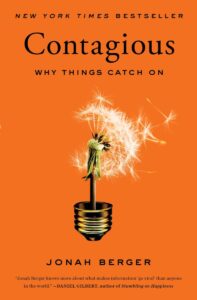Book Summary:
Contagious by Jonah Berger
Contagious by Jonah Berger

🛍️ Buy this book on Amazon (Audible, Kindle, or paperback): https://amzn.to/3wQUx4u
😋 Thanks! By buying books through my affiliate link, you’re supporting my work (and my marketing book collection).
🗒 Note: My notes are a mix of key ideas and quotes from the book as well as my own thoughts.
Why word of mouth is awesome
• Word of mouth is the primary factor behind 20% – 50% of all purchasing decisions.
• Word of mouth is 10x more efficient than traditional advertising.
• One 5-star review on Amazon leads to about twenty more books sold than a one-star review.
• Although we live in a digital world, only 7% of word of mouth happens online.
- AI-based targeting is nice, but when we recommend products to our friends, our targeting is much more precise. We know our friends better than any algorithms.
Example: A book publication sent the author two copies of a book so that he could pass the other one to a colleague. The publication knew that he would pick someone who would be able to appreciate the book.
The Six Principles of Virality
1. Social Currency
When people talk about products/content they like, they (often subconsciously) want to impress others. It’s the same as buying a nice car or wearing expensive clothes. They want to sound smart, cool, and rich.
”Give people a way to make themselves look good while promoting your products and ideas along the way.”
✨ Things that make people look good when they share them with others:
— Remarkable things: we want to share things that are extraordinary, novel, and entertaining. A good way to create such content/products is to take existing patterns and break them.
Example: a low-cost airline in which there are unlimited snacks and big seats is a remarkable thing.
— Leverage game mechanisms: we like to compete and compare ourselves with others. So if we turn our product into a game, like Duolingo or Wordle, people will want to share them.
— Insider knowledge: when we have something exclusive, it makes us feel unique and of high status. That makes us like the product more and tell others about it.
Example: a secret menu on the KFC menu.
2. Relevance, Triggers, and Associations
“Top of mind leads to tip of tongue,” meaning that our ideas have to be close to other subjects people might talk about. Consider the environment and triggers that your customer will see/hear/feel while making the buying decision. It’s not about making a catchy slogan but a relevant one. Environmental triggers make the difference between “immediate word of mouth,” which occurs right after you’ve seen or experienced something, and “ongoing word of mouth,” a conversation that always keeps going.
🧨 Examples of triggers:
🍷 Music in French triggered people to buy French wine.
🍓 Mentioning the word ‘tray’ in a slogan triggered students to eat more fruits because they lay on a tray.
🎒 People who vote in a school are more likely to vote for candidates who talk about education and schools.
3. Emotions
Caring leads to sharing, and certain emotions make people share more.
— Awe: when something is inspiring like a blind skateboarder or Susan Boyle.
— Content that arouses you: like funny content and stuff that make you angry.
— Sad things are rarely shared. Most people don’t want to carry bad news.
Tip: When people are already emotionally triggered, it is easier to make them share or take action.
4. Public
We are more likely to discuss things that are visible and public. Things that we can observe.
Example: Men grow their mustache to raise awareness for cancer. Other men see it, talk about it, and join too.
Bottom line: When you create an idea, make it sharable, and make it public for everyone to see.
Turn the private into the public: Lance Armstrong created his bracelet, bright and yellow, to collect donations. You could recognize it everywhere. This turned charity, which was considered a private matter before, into a public thing.
🍏 Some products have publicity built in. Like Apple’s email with its “sent from my iPhone” feature.
5. Practical Value
People like to help each other, and if there’s a video that shows how to save a few dollars or a usable life hack, they will share it to help others. It strengthens social bonds.
6. Story
When the product is baked into a good story, people will share it and mention the product naturally.
Some pricing tips
- The price that people are willing to pay for a product is always relative to another price.
- Meaning that $10 sounds cheaper if it’s discounted from $50 and not from $12.
- Rule of 100 for promotional offers or discounts:
⬆️ If it’s higher than $100, give a $ discount
⬆️ If the price is lower than $100, give a % discount
Learn how to write copy that sticks
Hey, it’s Shlomo. Thanks for reading my book summary 🙂
I’m building the world’s largest collection of techniques and tools for copywriters,marketers, and other creative creatures.
Currently, the website includes:
💡35+ step-by-step guides
🛠 150+ online tools
❤️ All for free